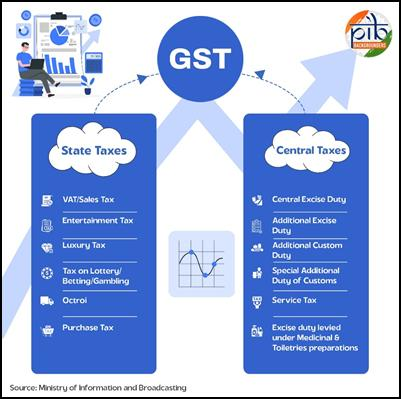Syllabus: GS3/ Economy
In Context
- India has completed eight years since the implementation of the Goods and Services Tax (GST) on July 1, 2017, a significant reform aimed at creating a “One Nation, One Tax” regime.
Key Aspects of GST
- Destination-Based Indirect Tax: GST is a destination-based tax, meaning the tax revenue accrues to the State where the goods or services are consumed, not where they are produced.
- This is a key shift from the earlier origin-based taxation system.
- Dual GST Model: India has adopted a dual GST model, meaning both the Centre and States/Union Territories (UTs) levy taxes on the supply of goods and services.
- Central GST (CGST): Collected by the Union government,
- State GST (SGST)/UTGST: Collected by the States/UTs,
- Integrated GST (IGST): Levied by the Centre on inter-state transactions and imports, and later apportioned between Centre and consuming State.
- Input Tax Credit (ITC): GST enables seamless flow of input tax credit across the supply chain. Businesses can claim credit for taxes paid on inputs used to supply taxable goods/services, thereby avoiding cascading of taxes.
- Zero-Rated Exports: Exports under GST are treated as zero-rated supplies. Exporters can claim refunds of input taxes paid, promoting competitiveness of Indian goods and services in global markets.
- The current GST structure consists of four main rate slabs: 5 percent, 12 percent, 18 percent and 28 percent.
- There are three special rates: 3 percent on gold, silver, diamond and jewellery, 1.5 percent on cut and polished diamonds and 0.25 percent on rough diamonds.
- A GST Compensation Cess is also levied on select goods such as tobacco products, aerated drinks and motor vehicles at varying rates. It is used to compensate states for any revenue loss resulting from the transition to the GST system.

Achievements of GST in 8 Years
- Unified Taxation Structure: GST subsumed 17 Central and State taxes and 23 cesses, reducing fragmentation and simplifying the tax regime.
- Increased Revenue Realisation: In 2024–25, GST recorded its highest-ever gross collection of ₹22.08 lakh crore, reflecting a year-on-year growth of 9.4 percent.
- The average monthly collection stood at ₹1.84 lakh crore.
- The number of active taxpayers has also seen a sharp rise. As of 30 April 2025, there are over 1.51 crore active GST registrations.
Shortcomings of GST
- Exclusion of Key Sectors: Important items such as petroleum (crude oil, diesel, petrol, natural gas, ATF) and alcohol for human consumption remain outside GST — defeating the goal of a truly unified tax system.
- Complex Rate Structure: India has multiple tax slabs — 0%, 5%, 12%, 18%, and 28% — along with special rates (0.25%, 1%, 3%) and Compensation Cess on luxury/sin goods. This increases classification disputes and litigation.
- Frequent Changes in Law and Compliance: Businesses, especially MSMEs, face difficulties due to frequent changes in return filing formats, late fee penalties, and evolving interpretation of rules.
- Inverted Duty Structure: Sectors like textiles and footwear face an inverted duty structure, where tax on inputs is higher than output, leading to working capital blockages.
- Input Tax Credit Restrictions: ITC is often denied due to procedural lapses or supplier non-compliance, causing unjustified burden on recipients.
- Delays in Dispute Resolution: The GST Appellate Tribunal (GSTAT) was not operational for years, leading to pendency of thousands of appeals and burdening High Courts.
Reforms Needed in GST (GST 2.0)
- Inclusion of Petroleum Products and Electricity: Current exclusions cause tax cascading and reduce input credit availability for sectors like logistics and manufacturing.
- Inclusion would expand the tax base, make pricing transparent, and remove distortion across sectors.
- Simplify Compliance for MSMEs: Introduce quarterly returns with simplified formats for small taxpayers.
- Provide automatic ITC reconciliation tools to avoid mismatches.
- Broaden the Tax Base: Review and rationalise exemptions, especially those with limited benefit or causing distortions.
- Include gig economy and digital services more comprehensively.
- Improve Input Tax Credit (ITC) Mechanism: Denial of ITC for procedural lapses (e.g., supplier not uploading invoice) has led to unfair burdens.
- Allow provisional credit and improve supplier-buyer reconciliation tools.
- Rationalisation of GST Slabs: Reduce slab multiplicity to improve compliance and reduce litigation.
- Reform in GST Council Functioning: Promote greater transparency, stakeholder consultations, and time-bound decisions.
- Consider weighted voting in cases of deadlock to uphold cooperative federalism.
| Goods and Services Tax (GST) Council – The Goods and Services Tax (GST) Council is a constitutional body established under Article 279A of the Indian Constitution through the 101st Amendment Act of 2016. – The Union Finance Minister is the Chairperson of the GST Council. – The GST Council makes recommendations to the Union and the States on key GST-related issues, including: 1. Taxes, cesses, and surcharges to be subsumed under GST 2. Goods and services to be subject to or exempt from GST 3. Model GST laws, principles of levy, and apportionment of IGST 4. Tax rates, thresholds, special provisions, and any other matter relating to GST – Dispute resolution: The Council also serves as a platform to resolve disputes between the Centre and the States or among the States themselves on GST-related matters. – The Centre has one-third of the total voting power, while the States collectively have two-thirds. |
Concluding remarks
- Eight years since its rollout, GST has transformed India’s indirect tax landscape, but it remains a work in progress.
- As India moves toward becoming a $5 trillion economy, GST 2.0 reforms are not just desirable—they are essential for sustaining growth, ensuring revenue stability, and promoting cooperative federalism.
Source: TH
Read our detailed article on Goods and Services Tax (GST)
Previous article
National Sports Policy (NSP) 2025
Next article
Sovereign Debt is Rising in Developing World